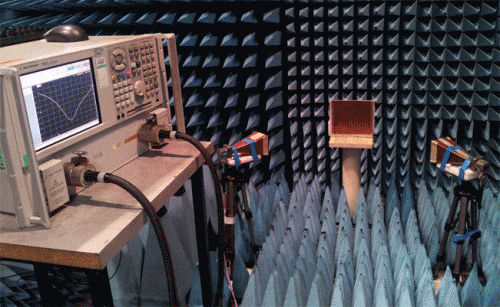Researchers develop cheaper and simpler radar-absorbent material

A radar absorbent material (RAM) that can operate over a broad range of frequencies and incident angles, is simple to manufacture, low cost, robust, and thin enough for conformal applications like aircraft cloaking has been developed by researchers at Queens University Belfast (QUB).
Traditional RAM, such as pyramidal shaped materials, or planar microwave absorbers including Salisbury screens and Jaumann absorbers, are unsuitable for radar 'cloaking' of structures aircraft, wind turbines and surface vehicles. Their thickness, weight and shaping clash with other, more fundamental, design drivers, for example the operating environment or aerodynamics.
Less bulky alternatives, like the Lockheed F-117 Nighthawk's nano-composite paint can be used, but these are very expensive and so unsuitable for most commercial applications. One lower-cost approach to creating thin, light RAM is the class of periodic structures called frequency selective surfaces (FSSs). As the name suggests, an FSS selectively scatters incident EM radiation according to its frequency. FSSs normally consist of an array of patterned conductors, backed by a thin dielectric. A microwave FSS absorber will also have a metal sheet inserted behind the resistively loaded patterned elements.
This lower-cost approach does come with more limited performance, as QUB team member Dr Robert Cahill explained: "The majority of the existing thin absorbers are narrowband and have poor angular and polarisation stability. They are also sensitive to the incidence angle, and it is difficult to achieve the precise surface resistance value required for each of the FSS elements."
However, the FSS absorber presented by the QUB researchers in this issue of Electronics Letters absorbs a wide range of frequencies over a wide range of incident angles, regardless of polarisation, and it is only 3 mm thick.
This thickness is around one tenth the wavelength of the radar radiation to be absorbed and much thinner than more traditional planar RAM, such as Salisbury screens that classically have a thickness of a quarter wavelength, but the material still achieves 90% backscatter suppression at incident angles up to 45°. The broad range of frequencies that are absorbed has previously only been possible with much thicker multilayer composite FSS structures, which are more difficult to manufacture and hard to use in conformal applications like aircraft coatings.
The team have further simplified manufacture by designing the width of the individual nested hexagonal loops in each unit cell to obtain a common value of surface resistance for all 4 elements, so the resistive material array of elements can be applied with a uniform thickness. The resistive material itself brings a cost saving as, for the first time, the QUB team have used a low-cost high-frequency paint normally used for EM shielding of buildings.
For vehicle and wind power applications of RAM, physical wear is a serious issue, but the FSS structure should be robust to this and can be easily protected from the environment using a thin watertight substrate.
Having shown the effectiveness of this structure, and that optimised performance is easily achievable for application specific wave polarisation and incident angles, the team are investigating other uses of the work, including shielding for body worn antennas. "For wearable applications like this, the rigid metal ground plane could be replaced by a very thin flexible conductor that would be more comfortable for the wearer, and the whole absorber structure integrated into textiles," said Cahill.
Discover the latest in science, tech, and space with over 100,000 subscribers who rely on Phys.org for daily insights. Sign up for our free newsletter and get updates on breakthroughs, innovations, and research that matter—daily or weekly.
The operating frequency of an FSS absorber can be changed simply by scaling the dimensions of the array elements and their ground plane separation, so the work is applicable to wavelengths of EM radiation outside radar frequencies. Only limited by fabrication tolerances, this class of FSS absorber is a viable alternative to conical and pyramidal RAMs commonly employed as hot and cold calibration loads for space-borne radiometers at millimetre and THz wavelengths.
The team are working to change the fabrication approach used as well. Until now, control of the surface resistance, via its relationship to the thickness of the patterned layer, has been the only physical variable available to the designer. QUB are developing a method with a doped conductive ink that can be used in any inkjet printer to pattern the FSS array, rather than the less precise stencil method used to construct the current prototype. This will allow the required surface resistance value of the loaded FSS structure to be precisely obtained using propriety processing.
In related work, they are hoping to build on recent research integrating liquid crystal substrates, with the aim of creating electronically reconfigurable absorbers that could switch between absorption and reflection states, or have their working frequency tuned on demand by applying a small voltage.
More information: "Simpler, low-cost stealth." Electronics Letters, Volume 51, Issue 2, 22 January 2015, page 127 DOI: 10.1049/el.2014.4426 , Print ISSN 0013-5194, Online ISSN 1350-911X, digital-library.theiet.org/del … &isFastTrackArticle=
Journal information: Electronics Letters
Provided by Institution of Engineering and Technology
This story is published courtesy of Electronics Letters. For additional Electronics Letters news and features visit theiet.org/eletters.

















